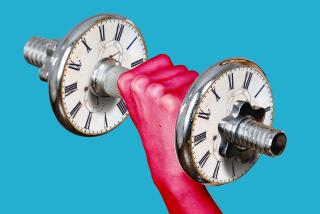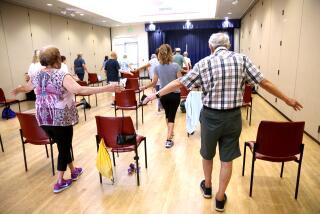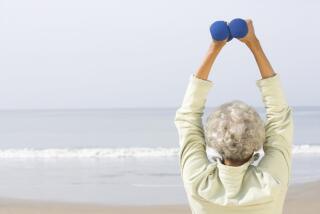This personal trainer offers the wisdom of his years
Supermodels aren’t the only ones who seemingly fade into the ether before they reach middle age. Cruise any number of commercial or private gyms and there’s one thing that’s almost always absent -- a personal trainer over 45.
That’s what makes John Roth such an anomaly. At 72, this personal trainer has several decades on his colleagues at 24 Hour Fitness in Thousand Oaks, where he’s carved out a niche training mostly older people for the last 4 1/2 years. Several, upon meeting Roth for the first time, have done a double-take themselves.
Roth jokes about being “the old guy” in the gym, but he clearly relishes the opportunity to work with seniors, many of whom have never seen a Bosu ball or cranked up an elliptical trainer. He knows he has something special to offer, something that can’t be found in certifications or workshops.
“I’ve been 30, 40, 50, 60 and 70,” he says. “I’ve had a lot of world experience, and there’s hardly anything I can’t talk to someone about. That’s when it becomes a meaningful experience to be in the gym, rather than being silent and doing repetitions.”
Roth’s lifelong dedication to fitness (give or take a few months) has given him the bouncy gait of a much younger man. These days he stays in shape by working out with clients and taking frequent walks around a nearby track. He’s his own fitness experiment, constantly testing to see how far he can push himself without suffering too many side effects.
Roth strides through the gym explaining his training method. New clients usually start in the gym’s circuit-training area, then move to weight machines and finally to free weights. Workouts are tailored to each person, but Roth is careful to strike a balance between challenging and overtaxing them. Core strength and stability are paramount for older clients who often struggle with balance problems that can lead to falls.
But sometimes training isn’t even about the equipment.
“This one woman I was training said she wanted to learn how to get up from a chair without looking old. She would go like this,” he says, bracing one hand behind him as he pushed up to a standing position. His alternative method: sitting on the edge of the chair and using core and quadriceps muscles to push up to a standing position.
Roth’s training career started as a semi-serious proposition to the then-manager of the gym. Having been laid off from his position as director of sales for the Lakers in 1998 at age 65, he searched for steady work, only to find his age a liability: “When I’d get turned down for a job I’d say, ‘Give me an honest answer -- does my age have something to do with it?’ And they’d say, ‘Yes.’ ”
Roth, who is married with two grown children, asked the manager “if he ever hired people with hip replacements who are over 65.” He had loved exercise since his youth, competing as a gymnast in high school, and thought he could channel his passion into a new profession. “He said if I could pass all the tests, yes. So off I went.”
Roth got a certification from the National Academy of Sports Medicine, with a specialization in working with older adults. The gym’s fitness counselors often pair him with seniors (some in their 80s), but Roth trains younger people in their late 30s and early 40s as well.
Dory Flood, 69, calls it a “fortunate fluke” that she was sent to Roth. The retired nurse from Moorpark joined the gym to lower her cholesterol, lose some of the weight she had gained since battling breast cancer and help strengthen her legs, weakened from neoplastic neuropathy.
“I was very surprised when I met him,” says Flood, who has belonged to gyms in the past and stayed active throughout her life with dance and tennis. “But it really made me feel kind of good that he was around my age. I thought, ‘If he can do it, why can’t I?’ That gave me a lot of incentive.”
On this day, Flood is working out with Roth; she’s been absent for a few months for health reasons. He concentrates on stretching exercises as well as building leg strength with various routines, including leg presses and squats using a stability ball against a wall. As Flood steps onto the treadmill, Roth explains why he reminds clients to walk heel-toe instead of flat-footed: “Older people tend to shuffle and not pick up their feet. That’s why they tend to fall down. Their foot catches on something.”
He pauses to check the calorie counter: “You’ve burned seven calories so far,” he says. “Now you can look at a piece of pie.”
Before his clients even touch a machine Roth demonstrates the correct form and explains why the exercise is necessary. Working out with 74-year-old Mel Flack, Roth lays out the reason for doing a chest press: “You’re stretching your pectoral muscles,” he explains, “and this is good for your posture.”
Flack, a retired high school teacher from Westlake Village, says he might have been happy with a trainer half Roth’s age but believes there are definite advantages to training with a peer: “We have a certain common history,” he says. “We’ve gone through all the same historical things. A younger person might not know the things I know, so it’s very easy to talk to John.”
What Roth offers clients is more than fitness knowledge, according to Billy McClendon, the gym’s general manager. “He truly understands how people feel. He has experienced the aches and pains associated with aging. Younger people can speak to it, but we haven’t experienced it. He understands it on a whole other level from the rest of us.”
Roth often commiserates with his clients about various twinges, pangs and spasms, and his hip replacement about four years ago has given him a better understanding of clients’ similar surgeries and conditions.
He also offers encouragement to those facing unemployment, the loss of a spouse or the frustrations of middle age. “Sometimes it’s a desperate form of working out,” he says, his voice softening. “You get women who are afraid they’re going to lose their husbands, or their husbands have taken off. I don’t take sides, but I try to help them get the big picture. I tell them that exercise is going to relieve their stress and they’re going to get better rest and, as a result, see things more clearly. And I keep them laughing.”
Roth may be something of a curiosity in the world of trainers, but gym owners are beginning to see the advantages an aging population will bring. As baby boomers grow older, no doubt the demographic of gym-goers will as well as boomers strive to stay in shape or counter the effects of a sedentary lifestyle. Even today, the majority (36%) of gym members are 35 to 54, and 19% are 55 and older.
Experts agree that exercise is imperative for older adults, and even beginning a program late in life can have great benefits. Seniors who might feel intimidated to step foot in a club may be less hesitant if they knew someone close to their age was there to guide them.
Roth needs no convincing that gyms should hire older trainers, but he’s also realistic about the financial difficulties of making a midlife or late-life career change. According to a 2002 survey taken by IDEA, an organization of health and fitness professionals, the mean salary for a trainer working at a health club was $29,000.
Still, Roth is optimistic that soon he may not be the only “old guy” trainer in the gym, that others his age will share his passion. “I want to get people to the point where coming to the gym is not something you have to do but that you want to do.”


